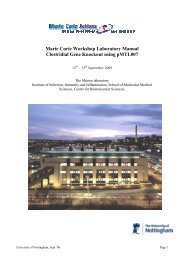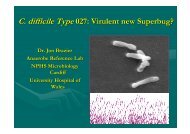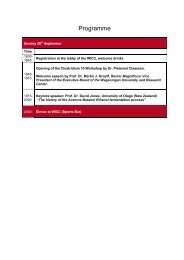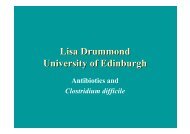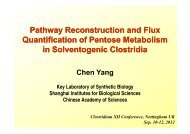abstract book - Clostridia
abstract book - Clostridia
abstract book - Clostridia
- No tags were found...
You also want an ePaper? Increase the reach of your titles
YUMPU automatically turns print PDFs into web optimized ePapers that Google loves.
TOXIN TYPING AND ANTIBIOTIC RESISTANCE PROFILES OFCLOSTRIDIUM PERFRINGENS ISOLATES ASSOCIATED WITH CASESOF SUDDEN DEATH AND ENTEROTOXAEMIA IN VEAL CALVES INBELGIUMA. Muylaert 1 , M. Lebrun 1 , J.-N. Duprez 1 , D. Chirila 1 , H. Theys 2 , J.G. Maini 11 University of Liège, Faculty of Veterinairy Medicine, Department ofInfectious Diseases, bacteriology, Sart Tilman B43a, B4000 Liège, Belgium.2 VILATCA nv, Kealverstraat 1, 2440 Geel.Sudden death in suckling beef calves is often associated with an overgrowthof Clostridium perfringens in the small intestine (>106 CFUs per ml ofcontent) following a decrease of the intestinal motility. C. perfringensproduce toxins causing a necro-haemorrhagic enteritis and the suddendeath after reaching the brain via the blood stream, so the name of «enterotoxaemia ». The C. perfringens isolated from typical cases belong tothe toxin type A and can also produce the consensus β2 toxin. The purposeof this work was to study cases of sudden deaths with lesions ofhaemorrhagic enteritis at necropsy in veal calves and to compare the resultswith those obtained in suckling beef calves. The 14 calves studied so farbelonged to beef cattle breeds. Their intestines were transported in ananaerobic jar within 2-4 hours to the diagnostic lab and the contents wereten-fold-diluted. Dilutions 3, 4 and 6 were plated onto Schaedler agar andincubated for 24 hours in an anaerobic cabinet. Up to ten typical colonieswere sub for toxin typing and antibiotic sensitivity testing. The 14 calveswere grouped as follows according to the necropsy findings : typical lesions(8 calves), suspicious lesions (3 calves), and absence of lesions (3 calves).Three of the calves with typical lesions were bacteriologically confirmed ascases of perfringens enterotoxaemia (>106 CFUs per ml), but 5 were not(106 CFUs perml). Sixty-five isolates from seven calves were tested for antibiotic sensitivityby the agar disc diffusion assay. All were resistant to erythromycin,lincomycin and tetracycline and 54 to penicillin G and tylosin, but none wasresistant to florfenicol. More cases will be studied. The detection of the α-, β-, ε-, ι-, β2 consensus, β2 atypic and entero-toxin-encoding genes will beperformed by PCR amplification and the different amplicons found will beconfirmed by sequencing. Further research is also needed to identify theaetiology of sudden death of bacteriologically negative calves.







